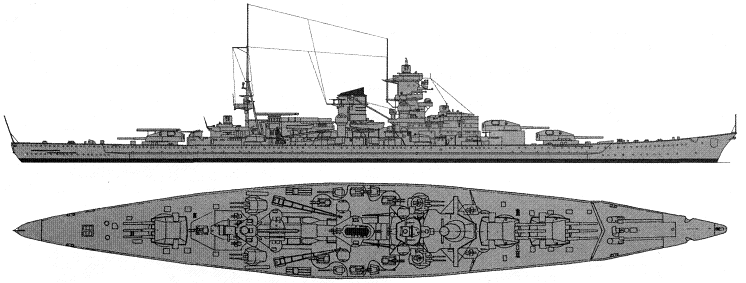
NAVYPEDIA
 Support the project with paypal
Support the project with paypal
Photo

Scharnhorst 1939
Ships
| Name | No | Yard No | Builder | Laid down | Launched | Comp | Fate |
|---|---|---|---|---|---|---|---|
| Scharnhorst | 125 | KMW Wilhelmshaven | 16.5.1935 | 30.6.1936 | 7.1.1939 | sunk 26.12.1943 | |
| Gneisenau | 235 | Deutsche Werke, Kiel | 3.5.1935 | 8.12.1936 | 21.5.1938 | damaged 12.2.1942, repair cancelled 7.1942 |
Technical data
| Displacement standard, t | 31053 |
|---|---|
| Displacement full, t | 37224 |
| Length, m | 226.0 wl 229.8 oa |
| Breadth, m | 30.0 |
| Draught, m | 8.23 normal load 9.91 deep load |
| No of shafts | 3 |
| Machinery | Scharnhorst: 3 sets Brown-Boveri geared steam turbines, 12 Wagner boilers Gneisenau: 3 sets Deschimag geared steam turbines, 12 Wagner boilers |
| Power, h. p. | 160100 |
| Max speed, kts | 32 |
| Fuel, t | Scharnhorst: oil 6108 Gneisenau: oil 5360 |
| Endurance, nm(kts) | Scharnhorst: 7100(19) Gneisenau: 6200(19) |
| Armour, mm | belt: 350 - 170, upper deck: 50, main deck: 80, slopes: 105, torpedo bulkhead: 45, main gun turrets: 360 - 150, secondary turrets: 140 - 50, CT: 350 - 105 |
| Armament | Scharnhorst: 3 x 3 - 283/51 SK C/34, 4 x 2 - 149/52 SK C/28, 4 x 1 - 149/52 SK C/28, 7 x 2 - 105/60 SK C/33, 8 x 2 - 37/80 SK C/30, 8 x 1 - 20/65 C/30, 2 catapults, 2 - 4 seaplanes (Ar196) Gneisenau: 3 x 3 - 283/51 SK C/34, 4 x 2 - 149/52 SK C/28, 4 x 1 - 149/52 SK C/28, 7 x 2 - 105/60 SK C/33, 8 x 2 - 37/80 SK C/30, 8 x 1 - 20/65 C/30, 2 catapults, 1 - 3 seaplanes (He114) |
| Complement | 1669 - 1840 |
Standard scale images

Scharnhorst 1940

Gneisenau 1938

Gneisenau 1942
Graphics
Project history
Building of battleships "D" and "Е" (4th and 5th ships of Deutschland class) has been authorised in 1933. In early 1934 it made the decision on placing of the third main turret and increase of displacement to 26000t. Increasing in calibre of artillery was cancelled on political accounts. As a matter of fact Scharnhorst and Gneisenau were battlecruisers with good protection, high speed and moderate fire power.
The hull had traditional construction: flush-decked, with external vertical armoured belt protecting citadel from fwd to aft main turrets. 350mm belt was tapered to 170mm at lower edge and closed by 150mm transverse bulkheads. Further to ship ends its thickness was moderated to 70mms at the same height. Above there was 45mm upper belt reaching an upper deck. Armour decks were two: 50mm upper and 80mm (95mm over magazines) main with 105mm slopes, not reaching lower edge of main belt, there was a 80mm glacis over boiler rooms. Protection of main turrets was so: 360mm faces, 220-180mm sides, 150-120mm rears, 100mm roofs. Thickness of barbettes was changed from 350mm aside to 200mm at centreline. Underwater protection had depth up to 5.4m and separated from vital compartments by 45mm longitudinal bulkhead. Total armour weight made 14245t, or 44% of displacement.
Main guns of C/34 model represented improved version of used on Deutschland class pocket battleships and used heavier shells (330kg AP, 315kg HE), shooting range has exceeded 40km, but construction of turrets remained former. In 1935 it was offered to replace triple 283mm turrets by twin 380mm, but in order to avoid completing delay it have refused. Similar replacement was planed to realise on Gneisenau in 1942-1944 during repair, however works have not been begun. Secondary artillery structure was dictated by presence of single mounts made for 4th and 5th pocket battleships. They have appeared not too successful addition to twin turrets (though all guns concerned to one model С/28). Ships had rather strong antiaircraft armament, and twin 105mm/65 and 37mm/33 mounts were 3d-stabilized. Fire control was realised by three main and secondary gun and four AA gun directors.
At designing of ships diesel machinery was refused in favour of turbines, with high parameters steam. It consisted from 12 Wagner boilers (58atm, 450°C) and three geared turbine units (Brown-Boveri on Scharnhorst and Deschimag on Gneisenau). Endurance has appeared below designed 8200(19)nm.
Originally both ships had almost straight stems with small bow flare, but during trials strong deck wetness of fwd end has come to light, then ships received clipper (so-called "Atlantic") stem. Among themselves Scharnhorst and Gneisenau were rather differed, first of all by mainmast arrangement.
Ship protection
Main belt between end barbettes (148x4.5m) had 350mm thickness tapering to 170mm at lower edge. This thick part closed by 150mm fore and 200mm aft bulkheads fwd from fore and aft from aft barbettes. Fore part of main belt had 70mm thickness ending at stem, aft part of main belt had 90mm thickness and closed by 150mm aft bulkhead of steering gear compartment. Upper belt was 45mm thick between end barbettes and 35mm between aft barbette and aft bulkhead of steering gear compartment. Main 80mm deck protected most part of hull (excluding few meters near stems) and (at the part between fore end barbette and aft bulkhead of steering gear compartment) connected with main belt (1m above its lower edge) by 105mm slopes inclined at 25° to horizontal. Thickness of slopes was decreased to 80mm over steering gear. Upper 50mm deck was flat and connected with upper edge of upper belt. Main gun turrets had 360mm faces, 200-110mm sides, 170mm rears and 150-90mm roofs. Thickness of barbettes changed from 350mm abreast sides to 200mm near center line. Secondary turrets had up to 140mm protection with 150mm barbettes, single 150mm guns had 25mm shields. Torpedo protection was 4.5m deep and included 45mm longitudinal bulkhead.
Modernizations
late 1938, Gneisenau: stem was reconstructed, length oa increased to 234.9m.
summer 1939, Scharnhorst: stem was reconstructed, length oa increased to 235.4m, hangar was lengthened, ship can carry 5 seaplanes (3 seaplanes in hangar and 2 on catapult)
10/1939, Gneisenau, Scharnhorst: + 2 x 1 - 20/65 C/30, FuMO 22 radar
late 1939, Gneisenau: stem was reconstructed, length oa increased to 235.4m
late 1939 - early 1940, Scharnhorst: 1 catapult (on "C" turret) was removed, ship can carry up to 4 seaplanes (including 1 on catapult)
2/1940, Gneisenau: 1 catapult (on "C" turret) was removed, ship can carry up to 2 seaplanes (including 1 on catapult)
1/1941, Gneisenau: - FuMO 22 radar; + 1 x 4 - 20/65 C/38, FuMO 27 radar
early 1942, Gneisenau: + 2 x 4 - 20/65 C/38, 2 x 1 - 20/65 C/38, 2 x 3 - 533 TT, FuMO 27 radar (2nd), FuMB 6 Palau ECM suite; hangar was enlarged, ship can carry 3 seaplanes (including 1 on catapult)
early 1942, Scharnhorst: - FuMO 22 radar; + 4 x 4 - 20/65 C/38, 2 x 1 - 20/65 C/38, 2 x 3 - 533 TT, 2x FuMO 27 radars, FuMB 6 Palau ECM suite
1943, Scharnhorst: + 3 x 4 - 20/65 C/38, FuMB 4, FuMB 7 ECM suites, displacement was 31848/38094t.
Naval service
Gneisenau 5.5.1940 was damaged on mine and was under repair 1 month, 20.6.1940 she was torpedoed by British submarine Clyde at coast of Norway and repaired 5 months, 6.4.1941 she was damaged by British torpedo bomber at Brest, 10.4.1941 damaged by British bombers and was under repair 8 months, 12.2.1942 she was damaged on a mine at Dutch coast, 27.2.1942 hard damaged by British aircraft at Kiel (direct hit of 454kg bomb) and repair was not completed; she was hulked 1.7.1942 and scuttled in Gotenhafen 28.3.1945.
Scharnhorst 8.6.1940 was torpedoed by British destroyer Acasta in Norwegian Sea and was under repair 7 months, 24.7.1941 she was damaged by British aircraft in La Pallice and repaired 4 months, 12.2.1942 damaged on two mines in the North Sea and repaired 4 months; 26.12.1943 she was lost in battle against British squadron (battleship Duke of York and cruisers Belfast, Jamaica and Norfolk and 4 destroyers) at Nordkap during an attempt to intercept convoy JW-55B, receiving many 356mm shells and 11 torpedo hits.
 HOME
HOME FIGHTING SHIPS OF THE WORLD
FIGHTING SHIPS OF THE WORLD GERMANY
GERMANY CAPITAL SHIPS
CAPITAL SHIPS SCHARNHORST battlecruisers (1938 - 1939)
SCHARNHORST battlecruisers (1938 - 1939)
